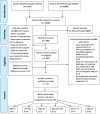Association of sleep duration and quality with blood lipids: a systematic review and meta-analysis of prospective studies
- PMID: 29247105
- PMCID: PMC5735405
- DOI: 10.1136/bmjopen-2017-018585
Association of sleep duration and quality with blood lipids: a systematic review and meta-analysis of prospective studies
Erratum in
-
Correction: Association of sleep duration and quality with blood lipids: a systematic review and meta-analysis of prospective studies.BMJ Open. 2025 Feb 16;15(2):e018585corr1. doi: 10.1136/bmjopen-2017-018585corr1. BMJ Open. 2025. PMID: 39956607 Free PMC article. No abstract available.
Abstract
Objectives: To assess the longitudinal evidence of the relationships between sleep disturbances (of quantity and quality) and dyslipidaemia in the general population and to quantify such relationships.
Setting: Systematic review and meta-analysis following the Preferred Reporting Items for Systematic Reviews and Meta-Analyses guidelines.
Methods: We performed a systematic search of PubMed and Embase (up to 9 September 2017), complemented with manual searches, of prospective population studies describing the association between sleep duration and quality and the incidence of dyslipidaemias. Relative risks (95% CIs) were extracted and pooled using a random effects model. Subgroup analyses by lipid type were performed. Heterogeneity and publication bias were also assessed. Quality was assessed with Downs and Black score.
Participants: Studies were included if they were prospective, had measured sleep quantity and/or quality at baseline and either incident cases of dyslipidaemia or changes in blood lipid fractions assessed prospectively.
Primary outcome measures: Incidence of dyslipidaemia and changes in lipid fractions. Dyslipidaemia was defined as a high total cholesterol, triglycerides, low-density lipoprotein cholesterol or low high-density lipoprotein cholesterol compared with the reference group.
Results: Thirteen studies were identified (eight using sleep duration, four sleep quality and one both). There was heterogeneity in the sleep quality aspects and types of lipids assessed. Classification of sleep duration (per hour/groups) also varied widely. In the pooled analysis of sleep duration (6 studies, 16 cohort samples; 30 033 participants; follow-up 2.6-10 years), short sleep was associated with a risk of 1.01 (95% CI 0.93 to 1.10) of developing dyslipidaemia, with moderate heterogeneity (I2=56%, P=0.003) and publication bias (P=0.035). Long sleep was associated with a risk of 0.98 (95% CI 0.87 to 1.10) for dyslipidaemia, with heterogeneity (I2=63%, P<0.001) and no significant publication bias (P=0.248).
Conclusion: The present analysis was unable to find supportive evidence of a significant relationship between sleep duration and the development of dyslipidaemia. However, heterogeneity and small number of studies limit the interpretation.
Prospero registration number: CRD42016045242.
Keywords: blood lipids; cholesterol; meta-analysis; sleep duration; sleep quality; systematic review.
© Article author(s) (or their employer(s) unless otherwise stated in the text of the article) 2017. All rights reserved. No commercial use is permitted unless otherwise expressly granted.
Conflict of interest statement
Competing interests: None declared.
Figures



Similar articles
-
Antidepressants for depression in adults with HIV infection.Cochrane Database Syst Rev. 2018 Jan 22;1(1):CD008525. doi: 10.1002/14651858.CD008525.pub3. Cochrane Database Syst Rev. 2018. PMID: 29355886 Free PMC article.
-
Couple therapy for depression.Cochrane Database Syst Rev. 2018 Jun 8;6(6):CD004188. doi: 10.1002/14651858.CD004188.pub3. Cochrane Database Syst Rev. 2018. PMID: 29882960 Free PMC article.
-
Glucocorticosteroids for people with alcoholic hepatitis.Cochrane Database Syst Rev. 2017 Nov 2;11(11):CD001511. doi: 10.1002/14651858.CD001511.pub3. Cochrane Database Syst Rev. 2017. Update in: Cochrane Database Syst Rev. 2019 Apr 09;4:CD001511. doi: 10.1002/14651858.CD001511.pub4. PMID: 29096421 Free PMC article. Updated.
-
Systemic pharmacological treatments for chronic plaque psoriasis: a network meta-analysis.Cochrane Database Syst Rev. 2021 Apr 19;4(4):CD011535. doi: 10.1002/14651858.CD011535.pub4. Cochrane Database Syst Rev. 2021. Update in: Cochrane Database Syst Rev. 2022 May 23;5:CD011535. doi: 10.1002/14651858.CD011535.pub5. PMID: 33871055 Free PMC article. Updated.
-
Impact of low-dose computed tomography (LDCT) screening on lung cancer-related mortality.Cochrane Database Syst Rev. 2022 Aug 3;8(8):CD013829. doi: 10.1002/14651858.CD013829.pub2. Cochrane Database Syst Rev. 2022. PMID: 35921047 Free PMC article.
Cited by
-
Sleep Duration, Lipid Profile and Insulin Resistance: Potential Role of Lipoprotein(a).Int J Mol Sci. 2020 Jun 30;21(13):4680. doi: 10.3390/ijms21134680. Int J Mol Sci. 2020. PMID: 32630105 Free PMC article.
-
Association Between Sleep Quality and Hypertension in Chinese Adults: A Cross-Sectional Analysis in the Tianning Cohort.Nat Sci Sleep. 2022 Nov 28;14:2097-2105. doi: 10.2147/NSS.S388535. eCollection 2022. Nat Sci Sleep. 2022. PMID: 36466133 Free PMC article.
-
Association between self-reported medical diagnosis of depression and metabolic syndrome in a population-based study: A propensity score-matched analysis.Nurs Open. 2022 Jan;9(1):367-376. doi: 10.1002/nop2.1074. Epub 2021 Sep 28. Nurs Open. 2022. PMID: 34582126 Free PMC article.
-
Exploring the relationship between sleep characteristics and cardiovascular biomarkers among adults aged 46-85 years measured in the Doetinchem cohort study.Sci Rep. 2025 May 27;15(1):18492. doi: 10.1038/s41598-025-03696-z. Sci Rep. 2025. PMID: 40425717 Free PMC article.
-
Difficulty of falling asleep and non-high-density lipoprotein cholesterol level among Canadian older adults: a cross-sectional analysis of the Canadian Longitudinal Study for Aging baseline data.J Geriatr Cardiol. 2021 Aug 28;18(8):597-608. doi: 10.11909/j.issn.1671-5411.2021.08.003. J Geriatr Cardiol. 2021. PMID: 34527026 Free PMC article.
References
-
- Cappuccio F, Miller MA, Lockley SW. Sleep, health, and society: the contribution of epidemiology, in sleep, health, and society: from aetiology to public health. USA: Oxford University Press, 2010.
Publication types
MeSH terms
Substances
LinkOut - more resources
Full Text Sources
Other Literature Sources
Medical
